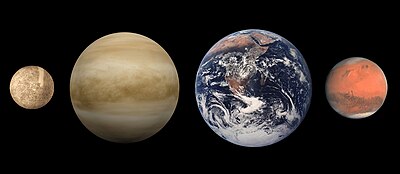Inner planet
The inner planets are the four planets closest to the Sun, that is: Mercury, Venus, Earth and Mars. They are small and have a high density (3-5 g/cm³) mainly due to transparent and rocky materials with a well-differentiated internal structure and a similar size. The isotopic composition of these bodies and their variable density (highest on Mercury and lowest on Mars) offer important clues about the formation of the solar system. All four have solid surfaces with the last three also possessing an atmosphere. The comparative study of the four planets makes it possible to study geological evolution in a broader context than just Earth.
Beyond the orbit of Mars is the asteroid belt, a region of the solar system in which there are abundant asteroids that never formed a planet.
From the astronomical point of view, each of the innermost planets Mercury and Venus have high phase angles and both it and Jupiter present a high retrograde motion in their apparent motion observed from Earth. The inner planets rotate slowly on themselves (Mercury 58 days, Venus 243 days, and around 24 hours for Earth and Mars). All of them emit a much lower flow of energy than they receive from the Sun.
Contenido relacionado
Uniform space
Centi
Scalar product

